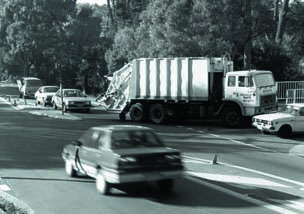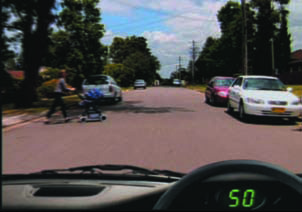The Hazard Perception Test
Expecting the unexpected
![]()

The role of expectancies
When you drive you rely on "expectancies". For example, you expect that other drivers will stop at red lights, that other drivers will give way when facing a Give Way sign and that pedestrians will not suddenly dash on to the road. Over time, drivers build up a range of expectancies based on their experiences with traffic. This helps experienced drivers become good at predicting how a hazard might develop.
Think about the roads that you drive on a lot (eg going to work, school or university). You get to know what lane you should be in, where there are often parked cars and where pedestrians often cross the road.
Expectancies are useful and help you manage the driving task. Expectancies are OK most of the time, but the unexpected does happen. This can lead to crashes when you rely on expectancies rather than hazard perception skills.
The unexpected
By now you will have realised that the road system is not perfect and that not all road users obey the road rules all of the time. Some road users do not do what you expect them to do.
Imagine the woman in the following picture did not look before crossing the road and so risked being struck by a car.
Perhaps she expected that no cars would be coming on a quiet suburban street. Drivers need to be on the look out for this sort of behaviour.
A driver with good hazard perception skills would have noticed the woman, taken action, and prevented a crash that may have killed or injured the woman and her child.
Expecting the unexpected
Suggesting that you expect the unexpected when driving is easy to say, but harder to do. Unfortunately, there are no magic formulas or techniques for predicting when unexpected hazards will pop up when driving.
The best way to deal with the unexpected is to apply the hazard perception skills covered in this handbook. The following are perhaps the key skills:
- Scan well ahead of your car - keep your eyes moving.
- Look for indicators on other vehicles.
- Observe the head and eye movements of other drivers (eg are they looking at you or at something else).
- Check for pedestrians, cyclists and motorcyclists that may be hidden by other vehicles.
- Give yourself plenty of time to detect and cope with hazards and space to take some action to avoid a crash.
- Slowing down is a good precaution as it gives you both time and space to cope with a hazard.
- Get lots of driving experience in a variety of traffic conditions so that fewer situations are new to you.
- If there is something that you feel you don't cope well with (eg heavy traffic), get a more experienced driver to help you learn how to deal with it (eg drive as a passenger with them, watch what they do and ask them questions).
- Be cautious and wary in situations that are new or different (eg roadworks, crash scenes).
- Make your car easier to see - if it is dull, overcast or raining turn your headlights on, even during the day.

Identifying the main hazard
Hazards rarely come one at a time when you're driving. Often you will have to deal with more than one at once. This means that you have to identify the main hazard and deal with this first. For example, in the following picture the car marked as B is the main hazard where you are the driver of the blue car. Car B has already started to back out of the parking space and may come out in front of you. Its brake and reversing lights are on. There are other hazards such as the vehicles marked A, C and D, but B is the one that poses the main and most immediate hazard to you.
While car B should wait until you pass, the driver may not have seen you or expects that you will let them out. On the other hand, you expect that the car will not move out until you have passed. Given that you need to expect the unexpected, it would be best to assume that the driver has not seen you until you have made eye contact and are sure that they will not come out in front of you. This means that you may slow down, move to the right of the lane to give yourself more space and cover the brake as precautions.
Key points summary: Expecting the unexpected
- drivers rely on expectancies when they drive
- the road system is not perfect - other drivers and road users sometimes do not do what you expect
- to cope with the unexpected, use the scanning routine and keep a safe distance from other road users
- hazards rarely come one at a time, so deal with the main hazard first
- give yourself time and space to cope
Practice exercises
Think about how well you dealt with any unexpected things that happened when you were driving in the past week. Did you have to brake or swerve to avoid a collision? Consider if you could have coped better and how this could have been done (eg spotting hazards earlier, scanning further ahead, giving yourself more space between you and other vehicles). Talk to other drivers that you trust about how they would have dealt with the situation. Could they have predicted that these situations would have played out the way that they did?
Reviewing your performance, and that of others, should help build your experience bank of hazards that can and do arise unexpectedly.
71-74































